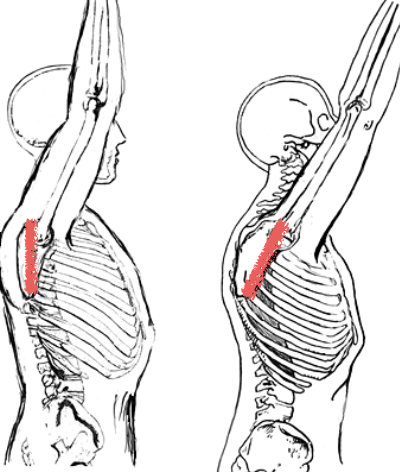Your Shoulder Hurts. Is Your Scapula Tilting?
Jan 22, 2015There are a few things in life that everyone knows to be true. We all have to pay taxes, we all will die one day and if you have poor extension in your upper back you will have a poor overhead position. Maybe the third one isn’t quite as obvious as the first two but it’s absolutely true!
Why is it that your upper back causes so many problems for the shoulder? That answer is very complex and for the sake of you borderline ADHD people like myself, I’ll keep this to one simple concept, scapular tilting.
Scapular tilting occurs anytime that we raise or lower our arm in front of us. In the picture below you can see the the shoulder blade of the person on the right is tilted forward more than the person on the left. This forward tilt is called anterior tilting of the shoulder blade. Anterior tilting is a problem because it creates a bone block as the arm raises overhead. You can’t push through this and force it into a better overhead position.
We can see in the person on the left in the same picture that the shoulder blade is now perpendicular with the ground. This is a good thing and called posterior tilting of the scapula. We need to get the shoulder blade into this position in order to achieve a full overhead position. This posterior tilt of the shoulder blade is primarily allowed by our upper back's ability to extend or flatten out. This is why people that have rounded or what we call kyphotic upper backs have a very difficult time with achieving a fully locked out overhead position.

So how do we get that thoracic spine to flatten out and allow the shoulder blade to tilt posterior? It's not easy if you have lost a ton of mobility, but here's a simple two-step process to start improving this movement.
1. Get the hell out of your chair!
If you sit for a long period of time everyday, chances are you have really poor mobility in your upper back. Get a standing desk or put your chair on your desk and force yourself to get out of that position. If you sit for 8 hours with a rounded upper back and think 5 minutes of mobility work will negate that, you're completely wrong.
2. Work on mobilizing to improve thoracic extension.
This is the hard part. You have to chip away at this problem daily if you have a significant loss in mobility. The good news is there's a ton of great video content out from my boy, Kelly Starrett on improving upper back mobility. Here's a great video to give you a better idea of what types of mobility techniques you need to add in to your training.
Good luck and leave us a comment if you have any questions.
-Danny
Let us help you figure out to live your best active life today!
Remember, Movement is Medicine!

